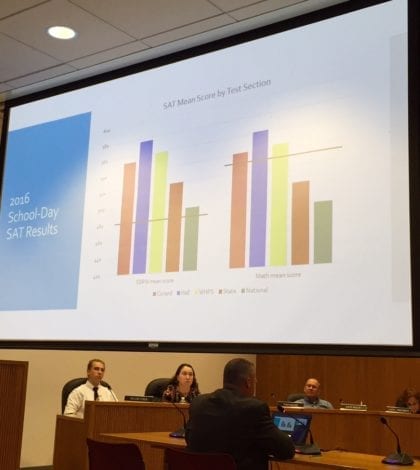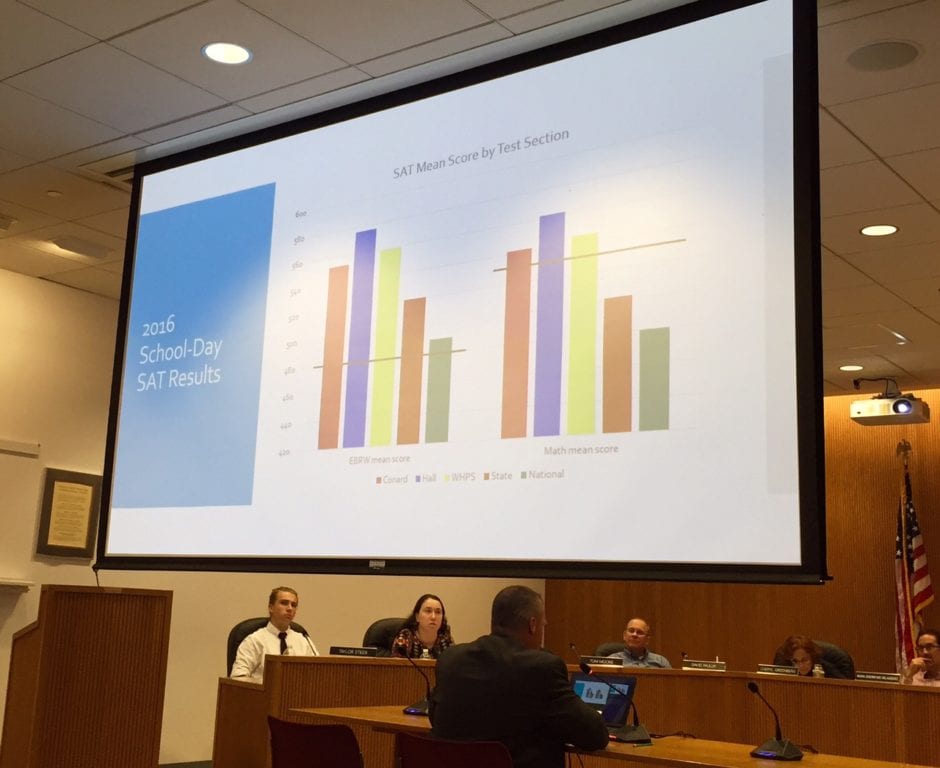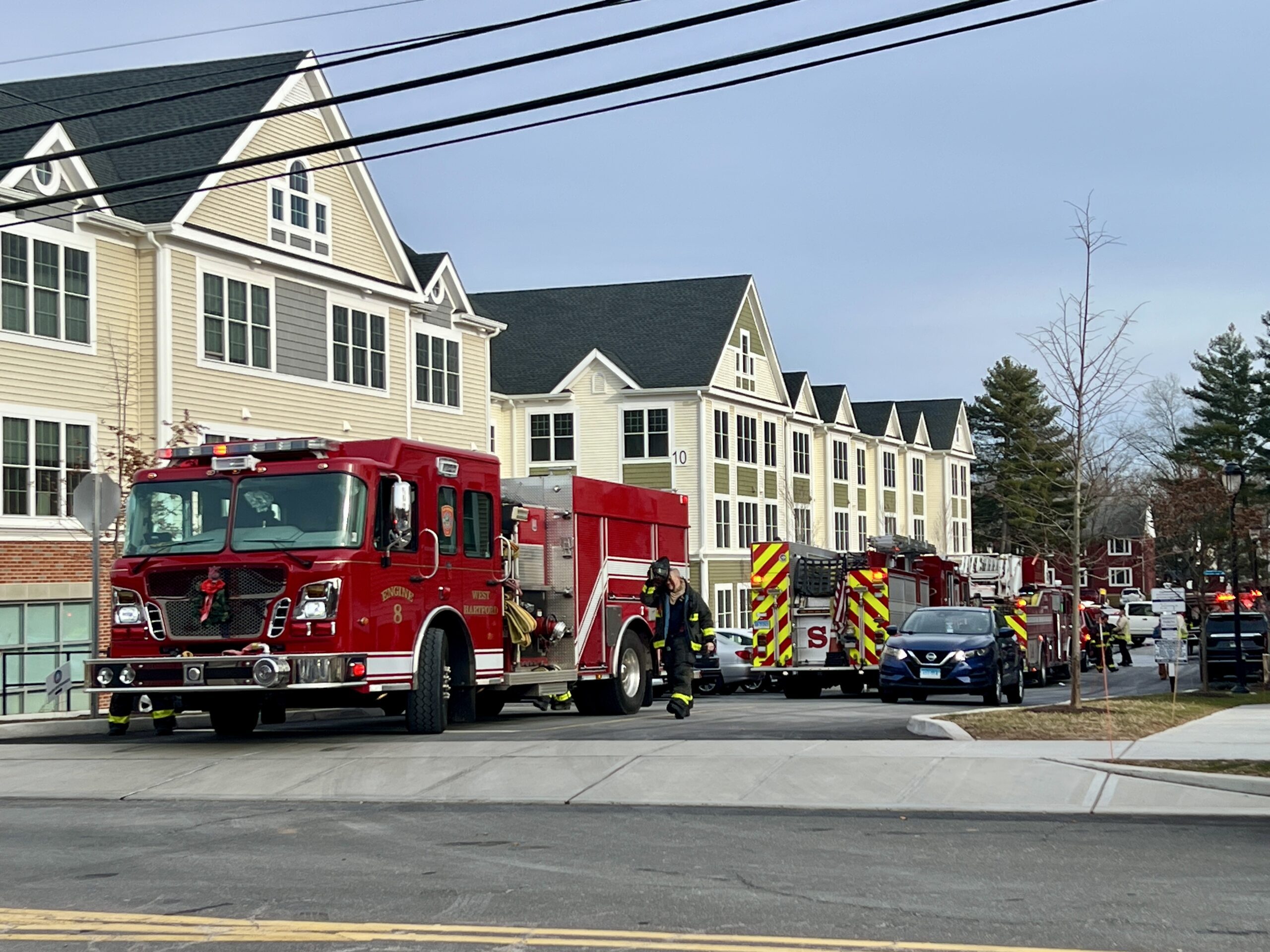West Hartford High School Students Have Positive Results on School Day SAT

Audio By Carbonatix

Assistant Superintendent Paul Vicinus presents results of the school day SAT to the Board of Education Tuesday night. Photo credit: Ronni Newton
Juniors at West Hartford’s Conard and Hall high schools, as well as high schoolers throughout the state, took the SATs in March 2016.

Assistant Superintendent Paul Vicinus presents results of the school day SAT to the Board of Education Tuesday night. Photo credit: Ronni Newton
By Ronni Newton
The West Hartford Board of Education received a report Tuesday night on how Conard and Hall students performed on the first-ever school day SAT, and results were very positive with overall scores in the top third of the state for mathematics and the top half of the state for EBRW (Evidence-Based Reading and Writing), Assistant Superintendent for Curriculum, Instruction and Assessment Paul Vicinus said.
The scores are only part of the reason, however.
Before Vicinus presented his report to the Board, Superintendent Tom Moore said that this is the first time that an analysis of SAT results has been done, because it’s the first time that all juniors have taken the exam. Giving all students access to the college search process – through mailings that are triggered when the student takes the exam – could be a game-changer for some students, bringing the “idea of just the possibility” of attending college. In the past, 80-85 percent of students took the SAT in West Hartford.
That, combined with the redesigned test, makes the SAT much more of a relevant standardized exam. Last fall, Connecticut received permission from the U.S. Department of Education to use the school day SAT as a replacement for the SBAC exam that was given to members of the class of 2016. Only three states used the school day SAT this year, but many others will be switching, Moore said.
The SAT was redesigned in the past year, and the test taken by the juniors (class of 2017) in March is more closely aligned to the Common Core standards. The PSAT taken in October 2015 was the first use of the redesigned test. The scoring has changed as well, and a 1/4 point penalty no longer applies to wrong answers.
Because of the structural change, Vicinus said that the scores are immediately elevated and the 2016 test will therefore serve as a benchmark to be used in comparison to future years. This year’s analysis focused on how students did in comparison to a statistically-set benchmark for college and career readiness in math as well as literacy.
“I’m glad to see our performance relative to the state is 40-45 points above the state average and 60-70 points above national average,” Vicinus said. The comparison to the national average is even more significant because in all but three states in 2016, only students planning to apply to college took the exam.
In West Hartford, 77 percent of students were able to reach the benchmark for EBRW, and 56 percent reached the benchmark in math, Vicinus said.
Students in the district scored on average a 559 in EBRW (553 at Conard and 576 at Hall) and 545 in math (542 at Conard and 562 at Hall). The state average is 520 for EBRW and 502 for math, and nationally averages are 490 EBRW/480 math.
The benchmark is 480 in EBRW and 530 in math.
The results are also broken down by how the “high needs” students performed – a group defined as economically disadvantaged, students with disabilities, English language learners. The high needs students in West Hartford outperform high needs students across the state by about 6 percent, Vicinus said, but the gap between high needs and other students in West Hartford is significant because the rest of the town’s population exceeded state averages by a greater percentage.
High needs students are combined by the state as a “visibility metric,” and in some districts there would otherwise not be enough students in each group to qualify for separate analysis. “The effort is not to excuse but to shine light because we know there are significant gaps there,” Vicinus said.
Vicinus further analyzed the scores by racial and ethnic groups. “Disaggregating these results across state-defined race/ethnicity categories provides a snapshot of an impetus to our ongoing work relative to achievement and opportunity gaps,” he wrote in his report. The gap was more pronounced in mathematics than in literacy, he said, and is overall something that needs to be addressed.
Vicinus delved into the results even more, analyzing groups by how long those students have been in the district. “It was at least some positive news, but still points to fairly significant gap that we need to look at as we move forward,” he told the Board.
The entire written report can be found on the West Hartford Public Schools website by clicking here.
Board member Cheryl Greenberg asked if students will be able to use the school day SAT results to apply to college, and Vicinus confirmed that they will. Some colleges require the writing section, which the state has determined will not be included in the school day SAT, and that may require a student to take the test again. In general, Vicinus said, most guidance counselors advise college bound students take three standardized tests, with students often taking the ACT once or twice in addition to the SAT.
Hall student representative Sarah Berman said she was considering taking the ACT a second time until she received her school day SAT scores on the newly-designed exam and they were higher than her relative ACT score. “The school day SAT gives you one free shot,” she said, and now she plans to take the SAT with the writing portion in October as her final standardized exam.
Several Board members questioned how the results of a test that is given in 11th grade, and analyzed when students are seniors, can be used to identify gaps in student learning.
Vicinus said it’s not something that can be used to “turn a ship around quickly,” but it’s a chance to take the SAT for free, and to have scores sent to colleges at no cost. State and federal law mandate a standardized exam for all high school students, and using the SAT – which the majority of students will take anyway – as that exam makes the most sense.
“Did West Hartford Public Schools prepare their students for college and career readiness? That’s what the state is looking at,” Vicinus said.
Moore said that in addition, it may result in opportunities for colleges to attract first time students who fit certain profiles – students that may not have taken the SAT in the past.
Board members agreed that taking the SAT may spark that option for students. “There are opportunities out there even if they say they can’t afford it. I hope students talk to their counselors,” Mark Zydanowicz said.
“Once you start receiving things in the mail that’s going to create an opening. It can change the outlook not only on that student’s life but for the whole family,” added Carol Blanks.
Like what you see here? Click here to subscribe to We-Ha’s newsletter so you’ll always be in the know about what’s happening in West Hartford!



